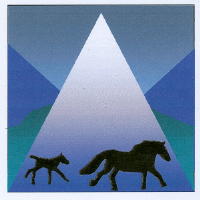Binoculars are My New Friend!
/It was just before sunset as I walked to the stallion pen to feed my Fell Pony Asi. As I walked, I scanned the hill south then east then west looking for the mare herd. I saw a bunch of dark-colored animals, so I noted the location so I could look from a better vantage point. When I got to that point, though, there were two bunches of dark-colored animals. Too many! I was confused! It was then that I realized that I would have to get friendly with binoculars.
While one of those bunches of dark colored animals was indeed the mares, the other was four pair of cows and calves who had wandered over the hill from the neighboring pasture. In the failing light of the day, glassing them allowed me to be sure that the ponies were all grazing or would look up when I called goodnight.
The next morning when I fed Asi, I again scanned the hill and spotted a bunch of dark colored animals to the west. Of course I didn’t have the binoculars with me, so I wasn’t sure if it was the mares or not. I debated whether to walk east to the house for the binoculars or west to see if I could get a more accurate look. I chose west, which ended up being the wise choice because the cattle came into view low on the hill, so it was indeed the mares up higher.
The next day, just after sunset, I saw dark objects moving across the hill midway up. This time I went back to the house for the binoculars because it was late and I didn’t have time to waste any footsteps. Those dark objects ended up not being the ponies. There were four elk grazing where the ponies had been a few days before. A pony then came into view farther down the hill where it was clear that it was indeed a pony, so I glassed that area and ascertained that all were well.
One night I found the ponies just before dark without need of visual assistance. And with them was a herd of deer, seen to the left of the ponies in the picture here. The hill is alive with creatures, and I can now see more of them with my new friend: binoculars!
© Jenifer Morrissey, 2020
















































